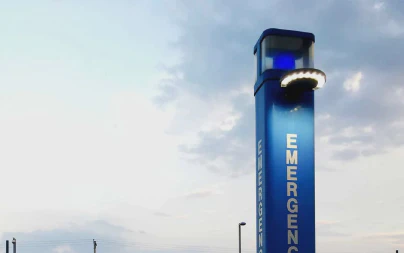Do blue light phones still protect students?

If you’ve visited a college campus sometime in the last decade or so, chances are you’ve seen emergency blue light phones scattered throughout campus grounds. These tall, blue pillars of safety have been a staple of campus community protection for about 30 years.
History of blue light phones on campuses
They can go by many different names: blue light phones, blue light stations, emergency call boxes, police assistance phones, etc. They owe their popularity to the 1990 Jeanne Clery Act and the subsequent national focus on campus safety initiatives.
Jeanne Clery was a student at Lehigh University in Pennsylvania in the 1980s. She was raped and murdered in her dormitory in 1986, a tragedy that her parents felt could have been prevented if the proper campus safety measures were in place.
Legislation for the Clery Act was passed in 1990, which subsequently cast a brighter light on a variety of campus safety issues at the time. One of those issues was a lack of direct communication between students and campus safety forces during potential emergencies on campus.
A year before the Clery Act passed, the University of Illinois at Chicago had sought out inventors for a device to extend the campus safety network. It wasn’t long before a company called News-Time delivered a prototype. By mid-1990, there were more than 100 of the iconic blue light phones on campus.
Other campuses followed this blue light phone trend. By 2005, over 90% of colleges and universities nationwide had installed blue light systems according to the Bureau of Justice Statistics.
How blue light phones work
The original devices were simple yet look similar to the familiar design we know today. A large, tall blue pillar with a blue light on top. When a person approaches the blue light lower, a noticeable red button can be pressed to alert campus authorities that you need assistance.
Today’s blue light call boxes are manufactured by a variety of companies and come with different enhancements and features. Most of them will maintain the identifiable pillar shape with the blue light on top. When the emergency button is pressed, the blue light will act as a beacon to deter potential aggressors and to assist campus police in finding the person’s location.
A speaker is also included on most models, allowing for the person in need to communicate with the dispatcher, and vice versa.
Additional enhancements may include a wide-angle camera (which can produce a video feed for dispatchers when the panic button is pressed), wireless and solar powered functionality, and integration with third party safety software.
Adapting to a new era of technology
The proliferation of smartphones and wireless technologies in the late-2000s forced campus administrators to think about safety in an entirely new way. Though blue light phones were still prominent, their usefulness and cost-effectiveness were starting to come into question.
If blue light towers were to remain a pinnacle of campus safety, their manufacturers would need to adapt.
Cutting the cord Wireless technology implementation is a huge upgrade to campus blue light phones. When first installed, blue light towers needed to have a hard-wired connection to a campus dispatcher, which would run underground like a traditional phone line. Today’s blue light phones have cut this cord, allowing for faster, less expensive installation.
Solar panels Solar powered blue light phones are becoming more popular in today’s campus safety environment. With these updated blue light systems, solar panels are attached to the top of the pole, just beneath the blue light, and assist in providing power to the unit. Some blue light poles can even be powered completely by solar energy, further reducing operating costs.
Video capabilities Camera integrations are also becoming popular for campus emergency blue lights. With a wide-angle video camera lens attached to the blue light, dispatchers and other operators can view the location of the blue light activation, giving them more insight into the situation and contacting the nearest security forces with potentially more pertinent information (visual description of potential assailant, direction of the people involved if they moved off camera).
Blue light tower cameras have a bit of an advantage over other, newer campus safety technologies when it comes to video feeds. When compared to smartphone apps for instance, despite smartphone camera capabilities, very few (if any) smartphone safety apps can include a useful video streaming function for when there is an emergency situation. If somehow the person needing emergency assistance were able to activate video streaming, there are huge challenges surrounding video quality, file size, storage and overall clarity (how often are you able to maintain a steady shot of yourself while walking with your smartphone let alone if you were in an emergency).
Tag-teaming campus safety with other technologies In reality, campus safety is a major priority for every college and no single solution is going to solve all campus safety needs. This means that it would be smart for different campus safety technology companies to work alongside one another and for campus administrators to look for products that are focused on integration and have expandable systems.
Many blue light companies have already established partnerships with other software companies and campus safety solution providers. Blue light towers can be installed with third party software integrations in mind and allow for a more complete campus safety solution.
One of the more popular pairings is with campus safety app providers. With this specific integration, blue light phones and smartphones work together to strengthen the mobility and stability of a campus’s safety network.
When a campus safety app user activates a panic via their smartphone, it can trigger blue light towers in the vicinity to light up and their integrated cameras to display to the dispatcher.
Likewise, when a blue light emergency tower is activated, campus safety apps can display a safety map to users, alerting them of the area’s blue light activation history.
Campus safety apps provide an extra layer of protection that works well with blue light systems and other campus safety technologies.
Learn more about how to evaluate safety apps.
Pros and cons of blue light phones
Blue light phone systems are ever-evolving to keep pace with the most recent safety technology. As it stands today, let’s go over some of the pros and cons of the basic blue light phone:
Pros
The latest and greatest - Many of today’s blue light towers are designed to take advantage of cutting-edge technology. And as the technology in the industry continues to progress, companies that provide blue light phones will adapt as well, cutting away old and outdated technology and workflows.
Helpful integrations - Blue light phone integrations are an integral part of the success of blue lights moving forward. Third party companies that deal in access control and safety apps are key partners in the overall campus safety initiative.
Deters crime - The iconic, recognizable blue towers are symbols of safety that can deter potential assailants from great distances. Even the sight of a single blue light phone from far away can be enough to prevent criminal activity in a large radius.
Cons
Mobility - By nature, blue light towers are immobile and therefore concede to other technologies, such as safety apps, to extend their protective reach beyond their physical location. With the proper integrations, mobility concerns can be greatly reduced.
Maintenance - Because blue light phones are physically placed on campus, there is cost involved with regards to installation and maintenance. With today’s materials, some manufacturers have been able to greatly reduce upkeep needs to near zero, but blue light tower maintenance is still worth consideration.
False alarms - Because of their accessibility and proliferation on some larger campuses, blue light systems can be targets for pranksters and those who do not need emergency assistance. These false alarms can be troublesome, but improving technologies and dispatcher workflows can help to reduce false activation workflow inefficiencies.
Staying on top of today’s campus safety requirements, challenges and solutions can be a daunting task. It can often take teams of people and multiple departments just to maintain a secure campus environment. To learn more about how you can bolster your security solutions, visit the 911Cellular website.
Campus safety information
Want to learn more about campus safety? We have the resources to get you informed and prepared. Visit our [campus safety] (https://www.911cellular.com/campus-safety/) page to find out more.
Tags: Hospital safety School safety Blue light towers Higher education safety

